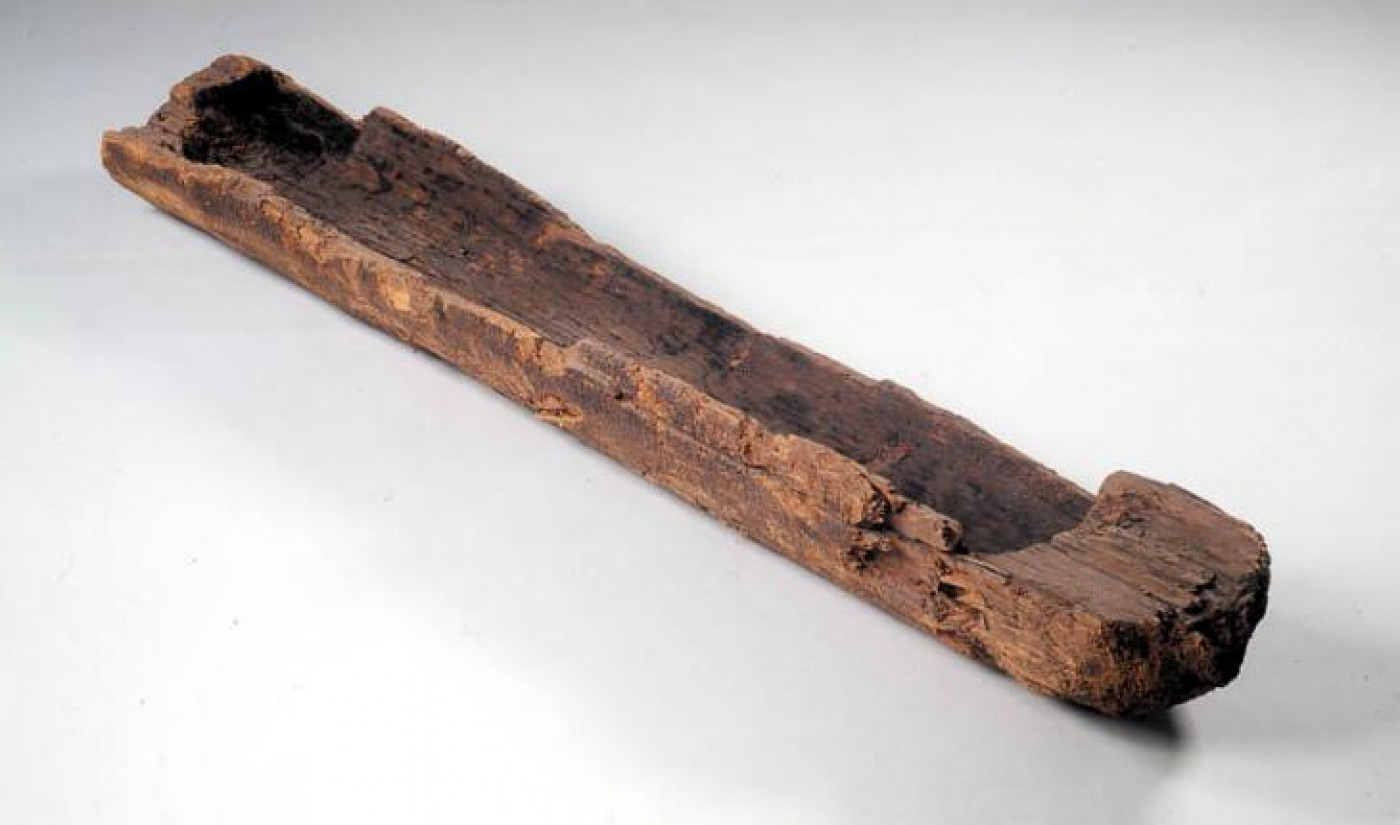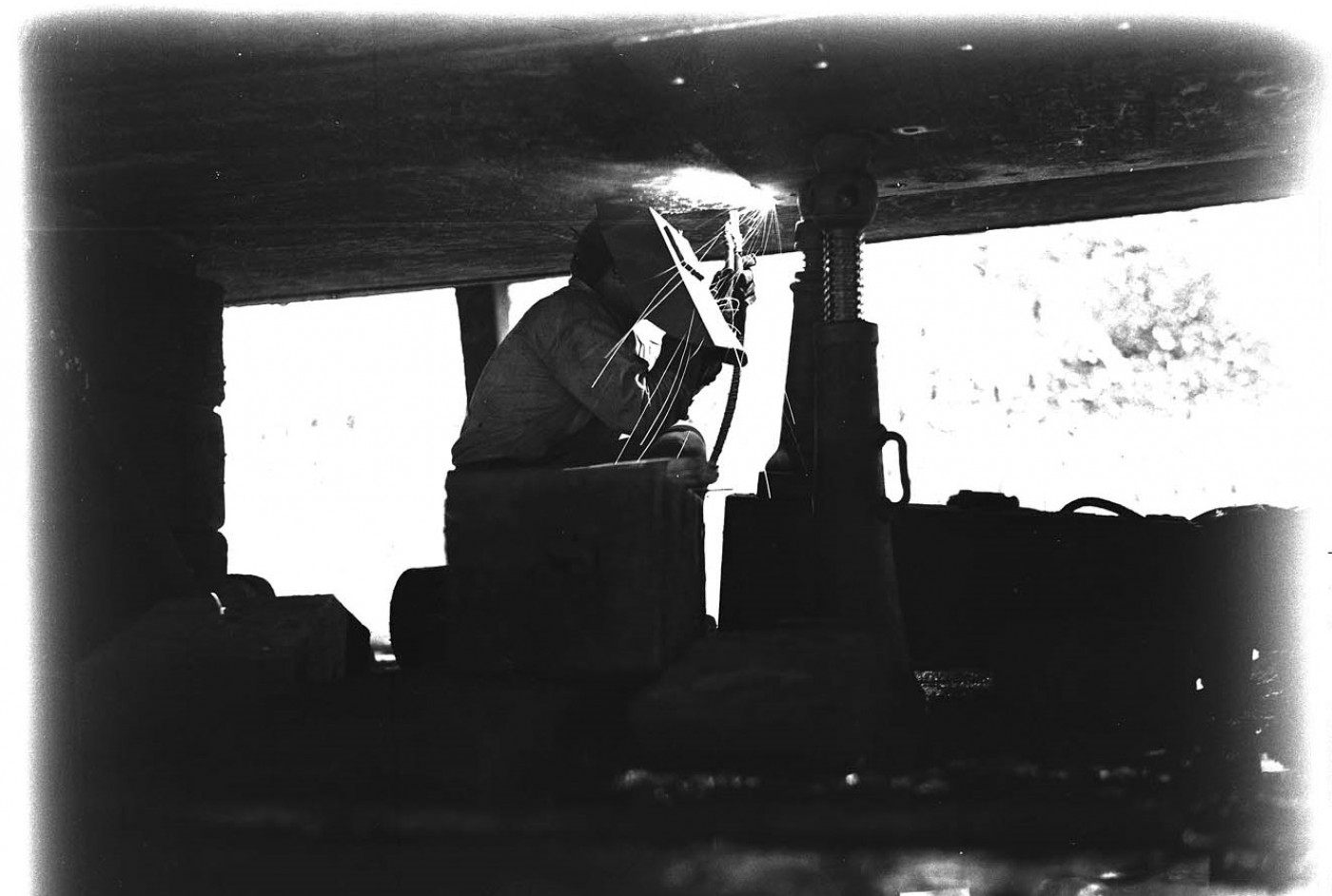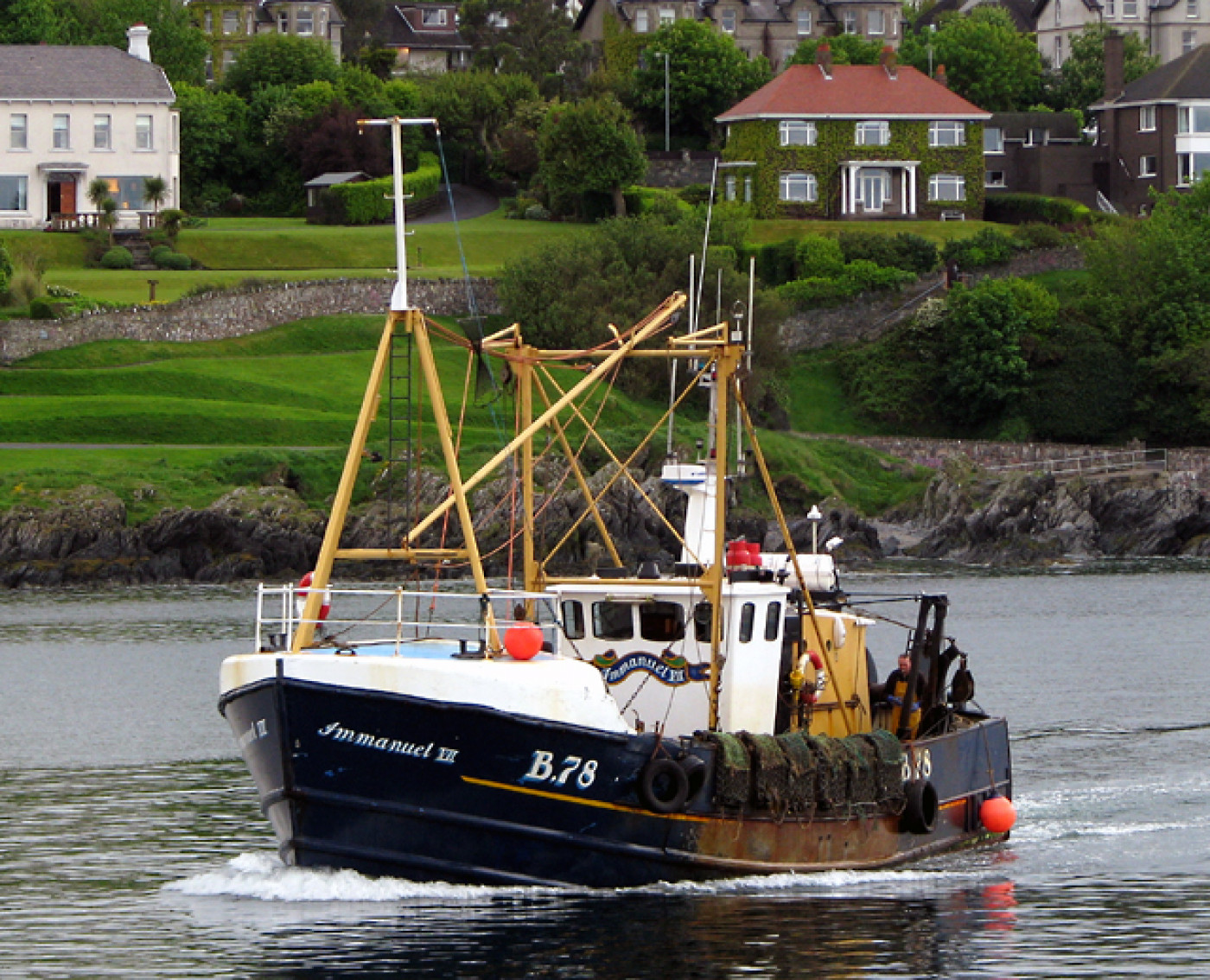In the 1830s, the Swedish Navy planted an oak forest of 300,000 trees on the island of Visingsö, all for the purpose of shipbuilding. By the time the oaks were fully mature, however, it was 1975. By then steel was the shipbuilder’s preferred choice and oak ships had long been relegated to history. 1 This anecdote is the perfect illustration of the evolution of shipbuilding materials from the 19th century to the modern day. However, the full story of what ships are made of is far more extensive, stretching several thousand years. From tiny dug-out boats to today’s steel mega-ships pushing modern technology to the limit, to light pleasure craft made of reinforced plastic, it is worth exploring the many materials that have been used to make ships and boats throughout history.
Since ancient times, wood has been a staple building material for watercraft. The earliest known wooden boat is the Pesse Canoe, found in the Netherlands in 1955. Dating back to around 8000BC, it is as simple as a wooden boat can be: a hollowed out tree trunk2.Two thousand years later, the ancient Egyptians are recorded to have used papyrus reeds woven together for their boats 3, but this was limited to river boats. Sea-going vessels required the strength provided by wood.

The Pesse Canoe from the Drent Museum, Netherlands. Drents Museum, CC BY 3.0 <https://creativecommons.org/licenses/by/3.0>, via Wikimedia Commons.
The Phoenicians were first recorded using large wooden ships in 1500BC 4. Wood remained the primary building material for boats and ships well into the Industrial Revolution. Ancient Greek triremes, Roman galleys, Chinese junks and Viking longboats all used the same fundamental design: a wooden hull propelled either by oars or sails. Sails were consistently made out of flax or linen throughout history, though cotton was also used 5 . Thus the historical ship was made of two main components: wood and cloth. What kind of wood depended on local availability, but generally, in Europe during the Middle Ages and all the way until the Industrial Revolution, oak (the same oak planted in Visingsö) was preferred for hulls due its strength, while softer pine was better for more flexible components 6.
For a long time, metal was little used in shipbuilding. Only a few components, such as rivets or the anchor, would ever use metal. Copper was used by the British and the United States in the late 18th century to cover wooden hulls, protecting them from rot and woodworm, but its use was limited 7. Iron and steel were not produced in high enough quantities or of sufficient purity for ships to be fully made out of metal. This changed with the introduction of the puddling iron-making process in 1784 8. High-grade iron began to creep into ship design, first with expanded fittings, then with braces that supported the hull, to fully iron warships such as HMS Warrior in 1860 9, though the first fully wrought iron passenger ship had already been built in 1843, with the steamship Great Britain 10.

HMS "Warrior" and sister ship "Black Prince", Britain's first iron warships. Artist: Charles Dixon. Public domain, via Wikimedia Commons.
This change enabled several new innovations. Wooden ships were limited in size by the strength properties of the material before it broke, whereas iron ships could be made larger. The advent of the steam engine, which generated far more propulsion than wind ever could, also meant ships could be heavier and larger while still being able to move. Combined with metal screw propellers, introduced in 1840, which were more efficient than paddles at getting the craft moving, ships entered a new area.
Another change came with creation of the Bessemer manufacturing process enabled steel to be made in large quantities. By 1880, steel had begun to replace iron in shipbuilding 11. It gradually grew in popularity until the Second World War, by which point ships were almost universally made of steel. To this day, steel remains the most popular material used for building large, heavy cargo ships. During this time, manufacturing techniques have changed significantly. In the 19th century, ships were still made with steel rivets, as they had been for hundreds of years. In the 1930s, however, this began to change. Large plates could be cut, bent and welded together.

A man welding the base of the naval sloop "Bellatrix" in Balmain, New South Wales, in the late 1920s. Photograph from the collection of the Australian National Maritime Museum.
This process did not come without its flaws, demonstrated most starkly by the mass-produced American Liberty-class ships of the Second World War. Inexperienced welders, the need for speedy manufacture, extreme temperature and the newness of the technology for war all contributed to these ships fracturing along the seams, sometimes so badly they had to be abandoned 12. However, these extreme conditions produced important lessons in steel ship manufacture that are still used today, such as better welding techniques and elimination of pressure points on the hull. Steel technology continues to be innovated, with alloys of steel and stainless steel having some specialised use in a ship’s hull to help prevent corrosion 13. When strength and size are the most important aspects of a ship, as with cargo ships, steel is preferred. However, for boats or ships where other properties are desired, different materials are used.
Aluminium is a lightweight metal and its lightness made it very attractive for shipbuilding. It was first used in the manufacture of vessels in 1891. Navies took interest in it almost immediately, with both France and the Russian Empire having a boat manufactured in 1894 and 1895 respectively. However, these were a failure as the material was not suited for riveting and pure aluminium corrodes easily in water 14. It took until the 1950s and 1960s to fix that problem. New alloys - combinations of aluminium, magnesium, and silicon - and the development of aluminium welding made it the preferred metal for small or medium ships such as patrol boats, and passenger vessels 15. Where lightness and speed are vital, aluminium is always first choice.
For very small boats, such as yachts and pleasure craft, fibreglass was and still is ideal. A plastic, reinforced with glass fibres and combined with resin, it is light, strong and easy to mould into many complex shapes 16, making it ideal for small boat building. The first fibreglass boat is generally considered to have been built in 1942 in Ohio, though it took until 1959 before the first mass-market fibreglass boat became available 17. Today, the average person in the market for a boat would most likely choose fibreglass. It is the favourite material for small, light craft like pleasure boats and fishing vessels.

"Immanuel VII", B7S in Bangor, a good example of a fiberglass fishing boat. Original photographer: Ross on geogrpah.co.uk CC BY-SA 2.0 <https://creativecommons.org/licenses/by-sa/2.0>, via Wikimedia Commons.
This is hardly an exhaustive list of all the materials and techniques used in building any kind of ship or boat. The process is so complex that it requires thousands of different materials for its many components. Nor has steel eliminated wood; wooden boats are still built, though they are mainly smaller pleasure boats. Nevertheless, it is staggering to think how different the enormous cargo ships of today are from the dugout canoes and reed boats, built thousands of years ago. The science of their materials and manufacture has advanced greatly. Shipbuilders of the past probably could not fathom the size, scale, and shape of the craft we can build today. Even a modest fibreglass boat taken out for a lazy afternoon of fishing is the result of much innovation. Most remarkable of all, the field is still evolving. It is exciting to think what materials the boats and ships of the future will be made from.
Disclaimer: The views and opinions expressed in this article are those of the author and do not necessarily represent those of the Lloyd’s Register Group or Lloyd’s Register Foundation.
Beamcut. “History of Steel in Shipbuilding.” Beamcut Systems (blog), 7 May 2021. https://beamcut.com/history-of-steel-in-shipbuilding/
Ceurstemont, Sandrine. “New materials to make ships more sustainable and less noisy for marine life.” Horizon Magazine, updated 13 April 2021. https://projects.research-and-innovation.ec.europa.eu/en/horizon-magazine/new-materials-make-ships-more-sustainable-and-less-noisy-marine-life
Sethi, Sargun. “What materials are used for building ships?” Marine Insight, 13 June 2019. www.marineinsight.com/guidelines/what-materials-are-used-for-building-ships/
Footnotes
-
1
JKPG.Com.“The oak forest on Visingsö.”Accessed 28 July 2024. https://jkpg.com/en/visingso/the-oak-forest-on-visingso/
-
2
Drents Museum. “Pesse Canoe, the oldest boat in the world.” Accessed 28 July 2024. https://drentsmuseum.nl/en/collection/pesse-canoe-the-oldest-boat-in-the-world
-
3
Royal Museums Greenwich. “Shipbuilding: The earliest vessels.” Accessed 28 July 2024. www.rmg.co.uk/stories/topics/shipbuilding-earliest-vessels
-
4
HMY Yachts. “A timeline of ships, boats, and yachts.” Accessed 28 July 2024. www.hmy.com/a-timeline-of-ships-boats-and-yachts/
-
5
Heritage Crafts. “Sail making.” 12 July 2024. www.heritagecrafts.org.uk/craft/sail-making/
-
6
Müller, Johann. “Tree species used in historical shipbuilding and their risk of being attacked by Teredinidae.” Skyllis Journal 10 (2010): 1-6.
-
7
Knight, Roger J.B. “The introduction of copper sheathing into the Royal Navy, 1779–1786.” Mariner’s Mirror, 59 (3): 299–309 (January 1973). https://doi.org/10.1080/00253359.1973.10657911
-
8
North Lanarkshire Council Museums Collections. “Puddlers, shinglers & rollers: the story of malleable iron.” Accessed 28 July 2024. www.culturenlmuseums.co.uk/story/puddlers-shinglers-rollers-the-story-of-malleable-iron/
-
9
Goodwin, Peter. “The influence of iron in ship construction: 1660 to 1830.” San Francisco Maritime National Park Association. April 1997. https://maritime.org/conf/conf-goodwin.php
-
10
Johnson, Ben. “SS Great Britain.” Historic UK, 6 March 2024. www.historic-uk.com/HistoryUK/HistoryofBritain/SS-Great-Britain/
-
11
Royal Museums Greenwich. “Shipbuilding at Greenwich.” Accessed 28 July 2024. www.rmg.co.uk/stories/topics/shipbuilding-1800-present.
-
12
Zhang, Wei. “Technical problem identification for the failures of the Liberty Ships.” Challenges 7, no. 2: 20 (2016). https://doi.org/10.3390/challe7020020
-
13
Metinvest. “Lords of the seas: shipbuilding steel.” 13 May 2020. https://metinvestholding.com/en/media/article/stalj-v-sudostroenii-ot-istorii-do-nashih-dnej
-
14
Aubert, M. “Aluminium user’s guide: Ch. 01, Aluminium, metal and the sea”. Almet Marine. pp.11-12. 2012. https://almet-marine.com/en/technical-informations/aluminium-users-guide
-
15
Haomei. “The history of aluminium alloys for ships.” Haomei Aluminum Co. Ltd. Accessed 28 July 2024. www.marinealu.com/a/the-history-of-aluminum-alloys-for-ships.html.
-
16
Connolly, Karen. “What is fibreglass or fiberglass?” FibreGlassDirect (blog), 24 July 2024. www.fibreglassdirect.co.uk/blog/post/what-is-fibreglass-or-fiberglass
-
17
Mitchell, Steve. “Birth of fiberglass boats.” Good Old Boat, November/December 1999. https://goodoldboat.com/birth-of-fiberglass-boats/



